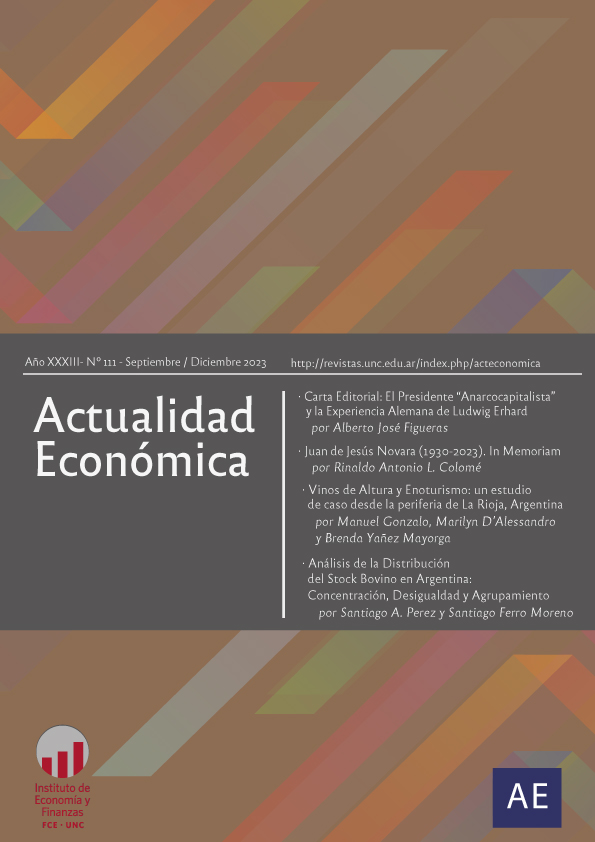Analysis of the Distribution of the Bovine Stock in Argentina: Concentration, Inequality and Clustering
Keywords:
cattle stock, diversification, intensificationAbstract
The bovine meat sector in Argentina has been showing various changes in recent years. Two of the most relevant are the increase in the bovine stock and the decrease in the number of producing establishments, which could imply a process of production growth with concentration. The objective of this work is to carry out an analysis on the inequality and concentration of cattle and bovine establishments in the provinces of Argentina in the period 2012-2021. For this, the GINI index and the Herfindahl-Hirschman index were built and obtained from the stratification of establishments, making a comparison of the evolution between the years raised. The results show that there is a good distribution of the stock by strata, but comparatively in the years there was an increase in inequality and concentration. Based on these two results, three groups of provinces could be formed.
Downloads
References
Anlló, G., Bisang, R., y Campi, M. (2013). Claves para repensar el agro argentino (1.a ed.). Eudeba.
Ariño, N., Miazzo, D. y Pisani Claro, N. (2022). Empleo en las cadenas agroindustriales. FADA. 73 pp.
Azcuy Ameghino, E. (2014). “Durmiendo con el enemigo”: capi-alismo y campesinado en Argentina. Revista Interdisciplinaria de Estudios Agrarios, Nº 40.
Azcuy Ameghino, E. y Fernández, D. (2019). El Censo Nacional Agropecuario 2018: Visión general y aproximación a la región pampeana. Revista Interdisciplinaria de Estudios Agrarios, 51. https://www.ciea.com.ar/web/wp-content/uploads/2020/08/2-CNA-RIEA-51-11-8-2020-5-36.pdf
Bisang, R. (2022). Del sector agropecuario a las redes agroindustriales: revisando supuestos del modelo stop and go. Revista de Ciencias Sociales 62 (236): 1-26.
Bona, L. (2020). Tendencias recientes en los cultivos y la producción ganadera en la provincia de Buenos Aires. Una mirada desde sus regiones productivas. Ciencia, Docencia y Tecnología, 32(62), 1-29. https://doi.org/10.33255/3262/775
Brown, M. (1994). Using Gini-style indices to evaluate the spatial patterns of health practitioners: theoretical considerations and an application based on Alberta data. Soc. Sci. Med. 38(9):1243-1256.
Capdeville, B. (2020). Transformaciones en la ganadería vacuna Argentina y la cuestión agraria actual, ¿qué culpa tiene la vaca? Revista Interdisciplinaria de Estudios Agrarios, 53(2), 24-49.
D´Angelo, G., Rodríguez Zurro, T. y E. Terré (2021). ¿Qué le aporta la agroindustria a la economía argentina? Informe técnico de la Bolsa de Comercio de Rosario. 10 pp.
Di Rienzo, J. A., Casanoves, F., Balzarini, M. G., González, L., Tablada, M. y Robledo, C. W. (2008). InfoStat, versión 2014, actualización 2018. Grupo InfoStat, FCA, Universidad Nacional de Córdoba, Argentina.
Diaz, J. R. y Perez, A. E. (2020). Pujas, fricciones y efecto de medidas coyunturales en la cadena de valor de la carne en Argentina. IV Congreso de Ciencias Sociales Agrarias. Universidad Nacional de San Luis.
Fernández, D. (2014). La ganadería pampeana. Concentración según subzonas productivas. 1988-2002. Documentos del CIEA No 10, 29-42.
Fernández, D. (2019). Midiendo la desigualdad en la distribución de la superficie productiva pampeana (1988-2002). Geograficando, 15(1), e053. https://www.memoria.fahce.unlp.edu.ar/art_revistas/pr.10063/pr.10063.pdf
Galindo, M. y V. Ríos (2015). Desigualdad. en Serie de Estudios Económicos, Vol. 1, Julio 2015. México DF: México.
Hacknikel, G. J., García, M. y Ramón, D. (2019). Consecuencias de la globalización. Una mirada sobre la ganadería pampeana argentina, 2008-2016. Brazilian Journal of Development, 5(9), 16533-16555. https://ojs.brazilianjournals.com.br/ojs/index.php/BRJD/article/view/3449/3276
Hernández Sampieri, R., Fernández Collado, C. y Baptista Lucio, P. (2014). Metodología de la investigación (6a. ed.). México D.F.: McGraw-Hill.
Instituto de Promoción de Carne Vacuna -IPCVA- (2023). Estadísticas de consumo promedio. http://www.ipcva.com.ar/estadisticas/vista_consumos_promedio.php
Martínez Dougnac, G. (2013). De los márgenes al boom. Apuntes para una historia de la sojización. En De especie exótica a monocultivo. Estudios sobre la expansión de la soja en Argentina. Martínez Dougnac, G., (comp.) (pp. 1-37).
Ministerio de Agricultura, Ganadería y Pesca -MAGyP- (2022). Plan de Ganadería Argentina. Documento de trabajo – Versión 1.0.
Ministerio de Economía (2021). Ganadería y carne vacuna. Informes de cadena de valor, año 6, N° 59. https://www.argentina.gob.ar/sites/default/files/ficha_sectorial_carne_bovina_-_diciembre.2021.pdf
Osatinsky, A. (2021). Concentración, desigualdad y deterioro laboral en la producción agrícola de Tucumán (1990-2020). Revista Breves contribuciones del Instituto de Estudios Geográficos Vol 32 (32): 30-53.
Paturlanne, J. (2019). Factores sistémicos que afectan la competitividad de los complejos agroalimentarios cárnicos de La Pampa. Tesis presentada para obtener el grado de magíster en Economía Agraria y Administración Rural. Departamento de Economía, Universidad Nacional del Sur. https://repositoriodigital.uns.edu.ar/bitstream/handle/123456789/4566/TESIS%20PATURLANNE.pdf?sequence=1
Ruiz, M., Feldkamp, C., Negri, R. y Apezteguia, I. (2022). Oportunidades para el financiamiento de la calidad en las PyMEs ganaderas argentinas. TMQ – QUALIDADE, 2. https://publicacoes.riqual.org/wp-content/uploads/2023/01/ed2_169_198.pdf
Servicio Nacional de Sanidad y Calidad Agroalimentaria -SENASA- (2022). Estadísticas de stock ganadero bovino. https://www.magyp.gob.ar/sitio/areas/bovinos/informacion_interes/informes/
Vertíz, P., García Bernado, R. y Mattos, E. (2022). La desigualdad en el complejo agroalimentario argentino. La cuestión de la tierra. Revista de Administración y Economía (6): 87-101.
Downloads
Published
Issue
Section
License

This work is licensed under a Creative Commons Attribution-NonCommercial-NoDerivatives 4.0 International License.
Those authors who have published with this journal, accept the following terms:
Authors will conserve their copyright and guarantee the magazine the right of first publication of their work, which will be simultaneously subject to the Creative Commons Attribution-NonCommercial-NoDerivative 4.0 International License that allows third parties to share the work as long as the author and first publication of this magazine are indicated.
Authors may adopt other non-exclusive license agreements to distribute the published version of the work (e.g., deposit it in an institutional telematic archive or publish it in a monographic volume) provided that the initial publication in this journal is indicated.
Authors are allowed and encouraged to disseminate their work through the Internet (e.g., in institutional telematic archives or on their website) before and during the submission process, which may lead to interesting exchanges and increase citations of the published work. (See The effect of open access)









